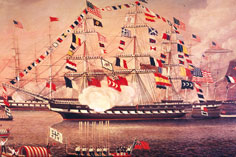Orchestra recounts the life of a forgotten black sailor
Kyle de Beausset
Nineteenth-century black Bostonian and sailor David Debias never made headlines during his life, but his story will soon be set to music.
“David and ‘Old Ironsides,’” an original piece commissioned by the Boston Landmarks Orchestra, will debut on July 31 in a free performance at the Charlestown Navy Yard.
Local luminary Rev. Ray Hammond of the Bethel A.M.E. Church will serve as narrator for the Charlestown performance of the story, which was written by Boston children’s author Constance Leeds. The author’s words were set to music by critically acclaimed composer Larry Thomas Bell, who also serves as chair of music theory at the Division of Preparatory and Continuing Education at the New England Conservatory of Music.
The three elements — story, music and narration — are intended to come together in a way that will appeal to an audience of children.
“It’s entertaining. The music is attractive — very cleverly put together. The story is well written,” said Charles Ansbacher, conductor and founder of the Boston Landmarks Orchestra. “We call it an incubation project, where we find a story that is narrated, not sung, so the children are caught up in the story and learn something from that. And at the same time they are also learning something about music.”
The approach draws its inspiration from another children’s story — a timeless classic that famously featured narration accompanied by an orchestra.
“It sort of builds on the idea of ‘Peter and the Wolf,’” Ansbacher said. “We’re trying to continue that tradition.”
While “David and ‘Old Ironsides’” is intended for children, Debias’ story also has significant social implications.
Debias was born free into a poor black family in Boston on Aug. 9, 1806, and enlisted in the U.S. Navy at the age of 9. He served two tours of duty on the USS Constitution — the nickname of which, “Old Ironsides,” gives the performance its name — and was discharged in 1824, after which he served on private merchant marine ships.
Between 1837 and 1838, Debias traveled from Alabama to Mississippi, where he was arrested in the town of Winchester as a runaway slave. Despite his claims that he was a free man, the burden was on Debias to prove his status. Judge Thomas P. Falconer wrote a letter to the Navy to inquire about Debias’ freedom on March 18, 1838, but after that, there is no information on Debias. All records from Wayne County, Miss., Courthouse were destroyed in a fire, and no reply from the Department of the Navy corroborating Debias’ status as a free man has ever been found.
“That’s one of the sort of darker aspects of the story,” said composer Bell, referring to the mystery of Debias’ fate.
Bell wrote the music from a child’s point of view to reflect the energy, optimism and excitement of that age. Ansbacher approached Bell because of his 2001 adaptation of the legendary fable “Hansel and Gretel.”
Lauren McCormack, a research coordinator at the USS Constitution Museum, first started digging into Debias’ story in the summer of 2005. The research culminated in a play, presented in February of this year by the USS Constitution Museum and hosted by the Museum of African American History, entitled “Stranger in a Strange Land: The Journey of a Black Sailor from Beacon Hill to the Decks of the USS Constitution.”
“We wanted to commission a work that was relevant to Boston, and to the nation,” Ansbacher said. “It’s a poignant story.”
“We are part of a naval history here in Boston,” and Debias’ story “tells of the social issues that confronted the country” at the time, he said.
In 2005, the orchestra also featured a work based on the story of Phillis Wheatley, an 18th-century African American poet and the first black female writer to be published in the United States.
After the July 31 performance of “David and ‘Old Ironsides’” at Charlestown Navy Yard, there will be other free performances at Boston’s Hatch Shell on August 1, the Shirley-Eustis House in Roxbury on August 2, the Adams National Historical Park in Quincy on August 2, and the Great Hall at Codman Square in Dorchester on August 3.
For more information on these and other Boston Landmarks Orchestra performances, visit www.landmarksorchestra.org. For more information on the USS Constitution Museum, visit www.ussconstitution museum.org.
|
|
This painting depicts the USS Constitution, nicknamed “Old Ironsides” because cannonballs could not penetrate the ship’s strong oak sides. David Debias, a 19th-century free black Bostonian, served two tours of duty on the ship in the early 1800s. Debias’ story serves as the basis of “David and ‘Old Ironsides,’” a new performance piece commissioned by the Boston Landmarks Orchestra that will debut on July 31 at Charlestown Navy Yard. (Photo courtesy of Boston Landmarks Orchestra)
|
|


